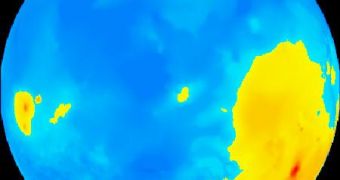Scientists have noticed a long time ago that Mars' northern and southern hemispheres are very different.
While the northern hemisphere is much flatter, it is also lower than the southern hemisphere, with an elevation difference between the two of about 5 km (3 mi).
In the 1980s, researchers supposed that the collision with a giant asteroid about 300 km (180 mi) in the planet's early history could have provoked the permanent depression in its northern hemisphere.
Now, researchers have made for the first time computer simulations to check this out. One simulation made at University of California in Santa Cruz, US, discovered that such an impactor would have induced huge amounts of lava, enough to wrap the planet with an ocean of molten magma 14 to 48 km thick.
In this case, any record of an impact would have been erased. "We therefore consider it unlikely that you'll create the Martian crustal dichotomy utilizing a single giant impact," said Shawn Hart, lead researcher.
However, simulations made by a second team at Caltech in Pasadena, US, underline that the giant impact could still have provoked the face that Mars has today only if it had struck a glancing blow.
Such an impact still provokes a depression, but releases less heat, melting only a relatively small zone around the hit zone and the whole lava amount resulted would have been the equivalent of a 5-kilometre-deep layer spread over the whole planet. "This would be small enough to avoid erasing the depression. You can have a very large impact and not melt the whole planet and preserve some signature of this impact," said Margarita Marinova, lead researcher.
"A giant impact may explain the crustal dichotomy. I think it's exciting work, but we don't have the whole picture yet" said William McKinnon of Washington University in St Louis, Missouri, US. "An unresolved question is exactly how the lava would arrange itself after such an impact. Where does the melt go and how much of the basin does it fill is a key issue," said Walter Keifer of the Lunar and Planetary Institute in Houston, Texas, US.

 14 DAY TRIAL //
14 DAY TRIAL //